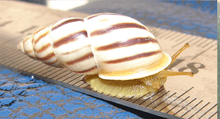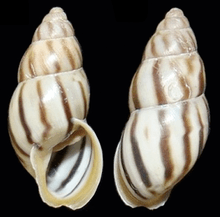Drymaeus cecileae
Drymaeus cecileae is a species of tropical air-breathing land snail, a pulmonate gastropod mollusk in the family Bulimulidae.
| Drymaeus cecileae | |
|---|---|
 | |
| Scientific classification | |
| Kingdom: | |
| Phylum: | |
| Class: | |
| (unranked): | clade Heterobranchia
clade Euthyneura clade Panpulmonata clade Eupulmonata clade Stylommatophora informal group Sigmurethra |
| Superfamily: | |
| Family: | |
| Subfamily: | |
| Genus: | |
| Subgenus: | Drymaeus |
| Species: | D. cecileae |
| Binomial name | |
| Drymaeus cecileae (M. J. Moricand, 1858)[1] | |
| Synonyms[2] | |
|
Bulimus cecileae Moricand, 1858 | |
Distribution
Distribution of Drymaeus cecileae includes Peru: Loreto Region,[2] Tarapoto (type locality),[3] and Juan Guerra, on the Huallaga River.[3]

Description
The living animal is brownish-beige throughout, including the tentacles.[2]
The shell is umbilicated, ovate-pyramidal, thin, translucid and shining.[3] The color is pale buff, with elegant longitudinal narrow tawny streaks.[3] The shell has 6 whorls, that are a little convex.[3] The last whorl is about as long as the spire.[3] The suture is impressed. The spire is conic and acute.[3] Aperture is little oblique, oblong, with a very pale lilac border within.[3] Columella is slightly arcuate.[3] Peristome is thin, expanded, buff or white, not continuous.[3]
The width of the shell is 7–10 mm.[3] The height of the shell is 17–22 mm.[3]
Specimen by Breure (2010)[2] corresponds to the description given by Pilsbry (1898).[2][3] He regarded this taxon as a colour form of Drymaeus strigatus, which, however, has always a lilac band on the inside, bordering the peristome.[2]
While Drymaeus species are known for their intraspecific variation in colour pattern, we here consider Drymaeus cecileae as a distinct taxon characterized by the more or less orange line behind the peristome, visible both on the inside and outside of the shell, and by being more slender than Drymaeus strigatus.[2]
References
This article incorporates public domain text from the reference [3] and CC-BY-3.0 text from the reference [2]
- Moricand M. J. (1858). "Description de quelques Coquilles nouvelles". Revue et Magasin de Zoologie Pure et Appliquée 10: 449-455. page 452, plate 14, figure 4.
- Breure A. S. H. & Mogollón Avila V. (2010). "Well-known and little-known: miscellaneous notes on Peruvian Orthalicidae (Gastropoda, Stylommatophora)". Zoologische Mededelingen 84. HTM Archived 2018-09-26 at the Wayback Machine.
- Pilsbry H. A. (1897-1898). "American Bulimulidae: Bulimulus, Neopetraeus, Oxychona, and South American Drymaeus". Manual of Conchology (2)11: 1-339. page 230, plate 42, fig. 52.